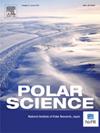喜马拉雅山西部 Panchi Nala 冰川消融区的年速度:趋势和控制因素
IF 1.5
4区 地球科学
Q3 ECOLOGY
引用次数: 0
摘要
关于冰川速度的信息对于了解冰川冰量、冰上特征演化和冰川-气候相互作用至关重要。本研究通过特征跟踪研究了喜马拉雅西部Panchi Nala冰川消融带(~ 4500-4800 m asl)的年速度。为此,使用光学感测图像和相关性(cos - corr)工具对2000年至2021年期间获得的多时段Landsat (TM和OLI)和Sentinel - 2 MSI图像进行了关联。结果表明,2000-2021年期间,消融区的平均速度为10.6±5.6 m/y,其中2005年和2015年的速度最高(13.8±4.6 m/y),最低(8.9±2.8 m/y)。在年际尺度上,速度变化趋势不明显,具有高度的不均匀性。此外,还研究了坡度、碎屑盖度、海拔、年平均气温和降水量等因素对冰川流速的影响。结果表明,冰川速度的年际异质性与夏季降水的变化呈负相关,表明夏季降水的增加会降低冰川速度。时空速度变化还与冰川上的冰池、冰崖和非均质碎屑分布有关。结果表明,虽然冰川速度的年际变化不明显,但其幅度一直较低,加之碎屑持续增加(19.74%)和平缓坡度(消融带上8.2°),可以促进冰上塘和冰崖的快速生长。本文章由计算机程序翻译,如有差异,请以英文原文为准。
Annual velocities of the ablation zone of Panchi Nala Glacier, western Himalaya: Trends and controlling factors
Information on the glacier velocity is imperative to understand the glacier ice volume, supraglacial feature evolution and glacier-climate interaction. The present study investigates annual velocities of the ablation zone (∼4500–4800 m asl) of Panchi Nala Glacier, western Himalaya through feature tracking. For this, multi-temporal Landsat (TM and OLI) and Sentinel −2 MSI images, acquired between 2000 and 2021, were correlated using the Co-registration of Optically Sensed Images and Correlation (COSI-Corr) tool. Results reveal a mean velocity of the ablation zone to be 10.6 ± 5.6 m/y during 2000–2021, with the highest (13.8 ± 4.6 m/y) and lowest velocity (8.9 ± 2.8 m/y) observed in 2005 and 2015, respectively. There is no significant trend in the velocity, rather it is highly heterogeneous on the inter-annual scale. Further, the influence of several factors such as slope, debris cover, altitude, annual average temperature and precipitation on the glacier velocity was investigated. Results indicate that the inter-annual heterogeneity in velocity is inversely correlated with the variation of summer precipitation implying that an increase in summer precipitation decreases the glacier velocity. The spatio-temporal velocity variations are also linked with the presence of supraglacial ponds, ice cliffs and heterogeneous debris distribution over the glacier. Findings indicate that, though annual glacier velocities have not changed significantly, their magnitudes are consistently low which coupled with consistent debris increase (19.74%) and gentle slope (8.2° over ablation zone) can promote rapid growth of supraglacial ponds and ice cliffs.
求助全文
通过发布文献求助,成功后即可免费获取论文全文。
去求助
来源期刊

Polar Science
ECOLOGY-GEOSCIENCES, MULTIDISCIPLINARY
CiteScore
3.90
自引率
5.60%
发文量
46
期刊介绍:
Polar Science is an international, peer-reviewed quarterly journal. It is dedicated to publishing original research articles for sciences relating to the polar regions of the Earth and other planets. Polar Science aims to cover 15 disciplines which are listed below; they cover most aspects of physical sciences, geosciences and life sciences, together with engineering and social sciences. Articles should attract the interest of broad polar science communities, and not be limited to the interests of those who work under specific research subjects. Polar Science also has an Open Archive whereby published articles are made freely available from ScienceDirect after an embargo period of 24 months from the date of publication.
- Space and upper atmosphere physics
- Atmospheric science/climatology
- Glaciology
- Oceanography/sea ice studies
- Geology/petrology
- Solid earth geophysics/seismology
- Marine Earth science
- Geomorphology/Cenozoic-Quaternary geology
- Meteoritics
- Terrestrial biology
- Marine biology
- Animal ecology
- Environment
- Polar Engineering
- Humanities and social sciences.
 求助内容:
求助内容: 应助结果提醒方式:
应助结果提醒方式:


